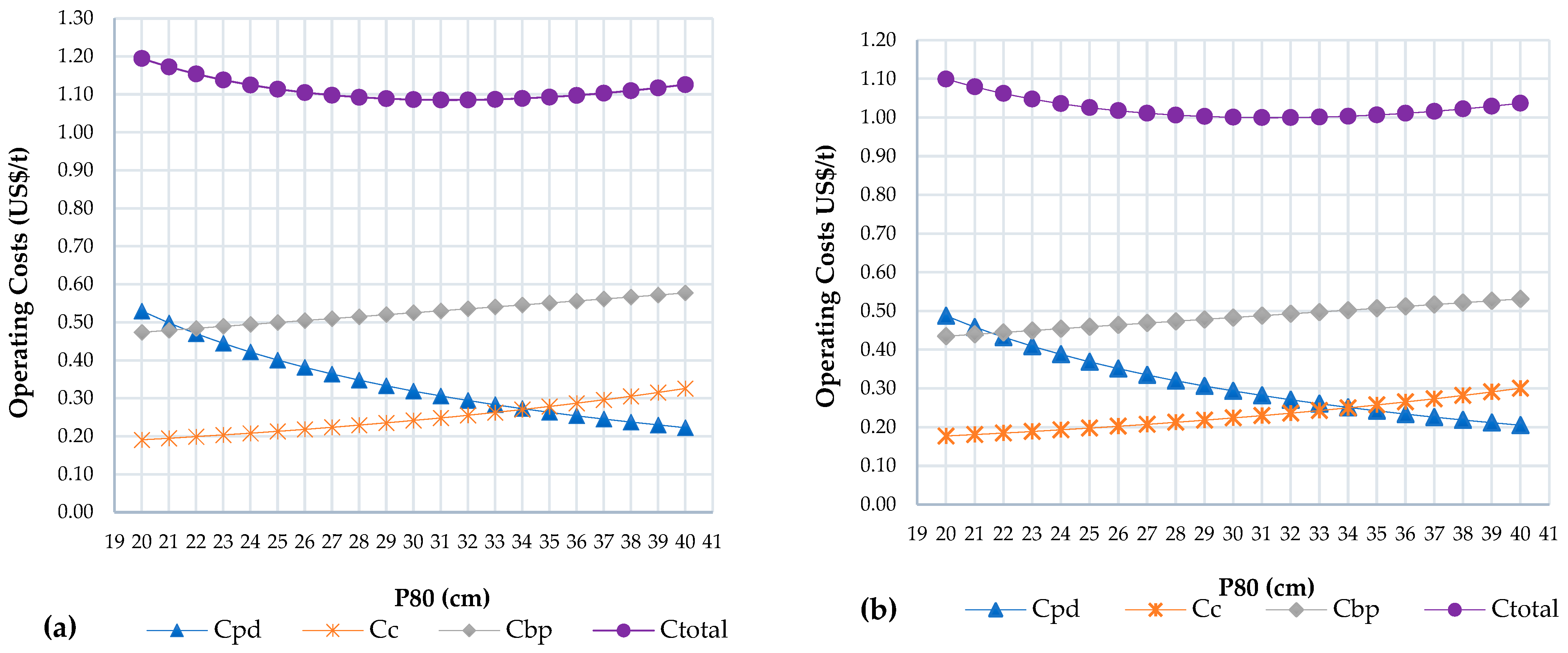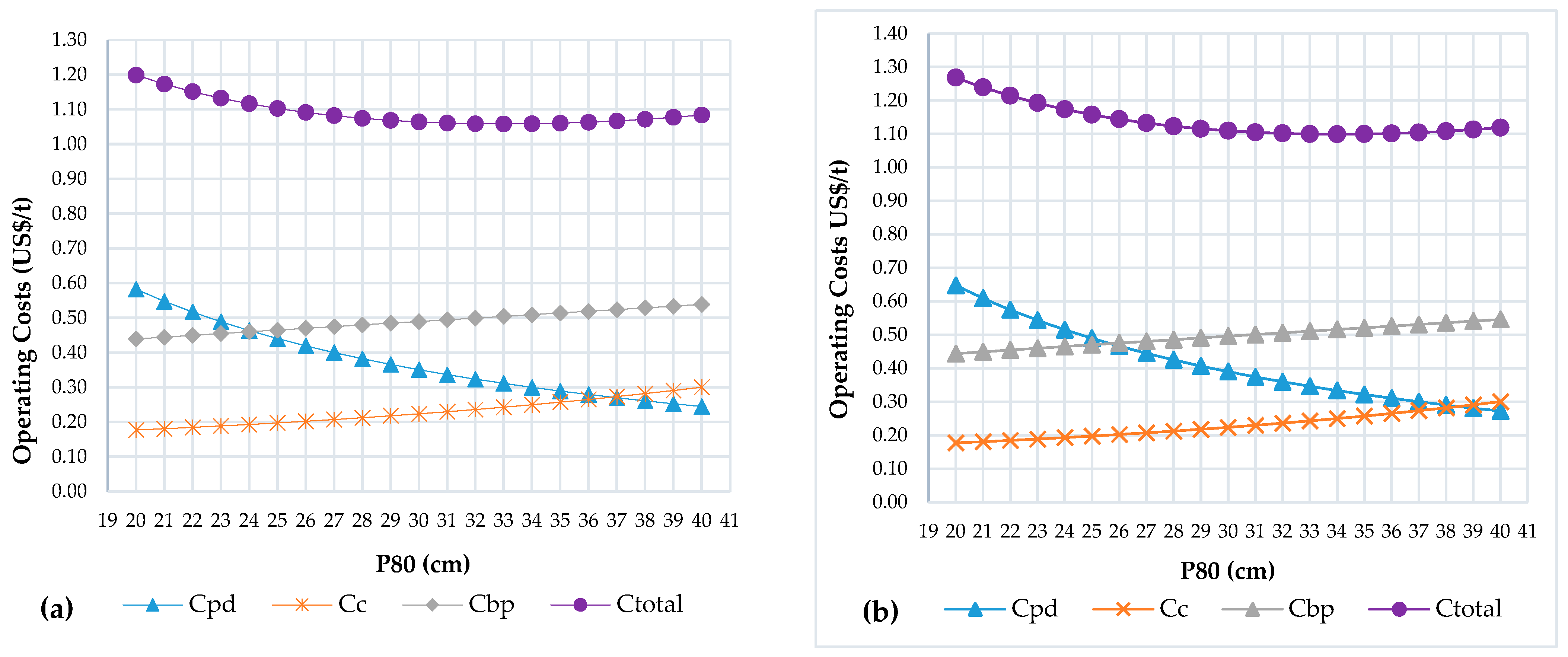A Mine-to-Crusher Model to Minimize Costs at a Truckless Open-Pit Iron Mine in Brazil
Abstract
:1. Introduction
2. Case Study
3. Materials and Methods
3.1. Drilling and Blasting
3.2. Loading and Primary Crushing
4. Results and Discussions
4.1. Model Calibration
4.2. Cost Minimization
4.2.1. Production Chain
4.2.2. Mine Operation Chain
5. Conclusions
Author Contributions
Funding
Institutional Review Board Statement
Informed Consent Statement
Data Availability Statement
Acknowledgments
Conflicts of Interest
References
- Bazaluk, O.; Petlovanyi, M.; Lozynskyi, V.; Zubko, S.; Sai, K.; Saik, P. Sustainable Underground Iron Ore Mining in Ukraine with Backfilling Worked-Out Area. Sustainability 2021, 13, 834. [Google Scholar] [CrossRef]
- Curry, J.A.; Ismay, J.L.M.; Jameson, J.G. Mine operating costs and the potential impacts of energy and grinding. Miner. Eng. 2014, 56, 70–80. [Google Scholar] [CrossRef]
- Paricheh, M.; Osanloo, M. Determination of the optimum in-pit crusher location in open-pit mining under production and operating cost uncertainties. In Proceedings of the 16th International Conference on Computer Applications in the Mineral Industries (Swemp2016), Istanbul, Turkey, 5–7 October 2016. [Google Scholar]
- Aguayo, I.A.O.; Nehring, M.; Ullah, G.M.W. Optimising productivity and safety of the open pit loading and haulage system with a surge loader. Mining 2021, 1, 167–179. [Google Scholar] [CrossRef]
- Atchison, T.; Morrison, D. In-pit crushing and conveying bench operations—Assessing the truckless mining option. Bulk Solids Handl. Arch. 2012, 32. Available online: https://news.bulk-online.com/bulk-solids-handling-archive/in-pit-crushing-and-conveying-bench-operations-assessing-the-truckless-mining-option.html (accessed on 11 August 2022).
- Tutton, D.; Streck, W. The application of mobile in-pit crushing and conveying in large, hard rock open pit mines. In Proceedings of the Mining Magazine Congress, Toronto, ON, Canada, 8–9 October 2009. [Google Scholar]
- Ozdemir, B.; Kumral, M. A system-wide approach to minimize the operational cost of bench production in open-cast mining operations. Int. J. Coal Sci. Technol. 2019, 6, 84–94. [Google Scholar] [CrossRef]
- Cameron, P.; Drinkwater, D.; Pease, J. The ABC of Mine to Mill and Metal Price Cycles; Australasian Institute of Mining and Metallurgy (AusIMM) Bulletin: Carlton, Australia, 2017; p. 9. [Google Scholar]
- Mckee, D.J. Understanding Mine to Mil, 1st ed.; The Cooperative Research Centre for Optimizing Resource Extraction (CRC ORE): Brisbane, Australia, 2013; p. 96. [Google Scholar]
- Adel, G.; Kojovic, T.; Thornton, D. Mine-to-mill optimization of aggregate production. In Semi-Annual Report No. 4; Virginia Polytechnic Institute & State University: Blacksburg, VA, USA, 2006; p. 168. [Google Scholar]
- Valery, W.; Jankovic, A.; La Rosa, D.; Dance, A.; Esen, S.; Colacioppo, J. Process integration and optimization from mine-to-mill. In Proceedings of the International Seminar on Mineral Processing Technology, Mumbai, India, 22–24 February 2007; pp. 557–581. [Google Scholar]
- Mahmoud, A.A.A. Development of an integrated mining and processing optimization system. Ph.D. Thesis, The Technische Universität Bergakademie Freiberg, Freiberg, Germany, April 2013; p. 234. [Google Scholar]
- Varannai, B.; Johansson, D.; Schunnesson, H. Crusher to Mill Transportation Time Calculation—The Aitik Case. Minerals 2022, 12, 147. [Google Scholar] [CrossRef]
- Navarro Torres, V.F.; Lopes, P.; Euzébio, E.; Peixoto, J.; Veras, E.; Reis, J.; Silva, L.S.; Lage, D. Effective Minimization of Production Costs in Open-Pit Mines [Minimização efetiva de custos de produção em minas a céu aberto]; Instituto Tecnlógico Vale: Ouro Preto, Brazil, 2017; p. 94. [Google Scholar]
- Nageshwaraniyer, S.S.; Kim, K.; Son, Y.-S. A mine-to-mill economic analysis model and spectral imaging-based tracking system for a copper mine. J. S. Afr. Inst. Min. Metall. 2018, 118, 7–14. [Google Scholar] [CrossRef]
- Park, J.; Kim, K. Use of drilling performance to improve rock-breakage efficiencies: A part of mine-to-mill optimization studies in a hard-rock mine. Int. J. Min. Sci. Technol. 2020, 30, 179–188. [Google Scholar] [CrossRef]
- Faramarzi, F.; Mansouri, H.; Ebrahimi Farsangi, M.A. A rock engineering system based model to predict rock fragmentation by blasting. Int. J. Rock Mech. Min. Sci. 2013, 60, 82–94. [Google Scholar] [CrossRef]
- Zhang, Z.X.; Qiao, Y.; Chi, L.Y.; Hou, F. Experimental study of rock fragmentation under different stemming conditions in model blasting. Int. J. Rock Mech. Min. Sci. 2021, 143, 104797. [Google Scholar] [CrossRef]
- Ke, B.; Pan, R.; Zhang, J.; Wang, W.; Hu, Y.; Lei, G.; Chi, X.; Ren, G.; You, Y. Parameter optimization and fragmentation prediction of fan-shaped deep hole blasting in Sanxin gold and copper mine. Minerals 2022, 12, 788. [Google Scholar] [CrossRef]
- Nikkhah, A.; Vakylabad, A.B.; Hassanzadeh, A.; Niedoba, T.; Surowiak, A. An evaluation on the impact of ore fragmented by blasting on mining performance. Minerals 2022, 12, 258. [Google Scholar] [CrossRef]
- Monjezi, M.; Rezaei, M.; Yazdian Varjani, A. Prediction of rock fragmentation due to blasting in Gol-E-Gohar iron mine using fuzzy logic. Int. J. Rock Mech. Min. Sci. 2009, 46, 1273–1280. [Google Scholar] [CrossRef]
- Beyglou, A.; Johansson, A.; Schunnesson, H. Target fragmentation for efficient loading and crushing—The Aitik case. J. S. Afr. Inst. Min. Metall. 2017, 117, 1053–1062. [Google Scholar] [CrossRef]
- Leng, Z.; Fan, Y.; Gao, Q.; Hu, Y. Evaluation and optimization of blasting approaches to reducing oversize boulders and toes in open-pit mine. Int. J. Min. Sci. Technol. 2020, 30, 373–380. [Google Scholar] [CrossRef]
- Zhang, Z.X. Impact of rock blasting on mining engineering. In Proceedings of the 5th International Conference & Exhibition on Mass Mining, Luleå, Sweden, 9–11 June 2008; pp. 671–680. [Google Scholar]
- Brunton, I.; Thornton, D.; Hodson, R.; Sprott, D. Impact of blast fragmentation on hydraulic excavator dig time. In Proceedings of the Fifth Large Open Pit Mining Conference, Kalgoorlie, Australia, 3–5 November 2003; Australasian Institute of Mining and Metallurgy (AuSIMM): Carlton, Australia; pp. 39–48. [Google Scholar]
- Jethro, M.A.; Shehu, S.A.; Kayode, T.S. Effect of Fragmentation on Loading at Obajana Cement Company Plc, Nigeria. Int. J. Sci. Eng. Res. 2016, 7, 608–620. [Google Scholar]
- Wills, B.A.; Finch, J.A. Wills’ Mineral Processing Technology. An Introduction to the Practical Aspects of Ore Treatment and Mineral Recovery, 8th ed.; Butterworth-Heinemann: Oxford, UK, 2015. [Google Scholar]
- Gupta, A.; Yan, D. Mineral Processing Design and Operations, 2nd ed.; Elsevier: Amsterdam, The Netherlands, 2016. [Google Scholar]
- Kim, K. Rock Fracturing & Mine to Mill Optimization. Ph.D. Thesis, The University of Arizona, Tucson, AZ, USA, 2012. Available online: http://hdl.handle.net/10150/242456 (accessed on 1 August 2022).






| Mine Operating Phase | Mine Operating Costs | |
|---|---|---|
| US$/Year | US$/T | |
| Total | 178,585,285.22 | 2.43 |
| Drilling and blasting | 29,021,194.67 | 0.40 |
| Loading | 15,757,463.44 | 0.21 |
| Truckless transport | 25,497,715.91 | 0.35 |
| Infrastructure | 60,064,228.39 | 0.82 |
| Mine Support | 18,557,182.45 | 0.25 |
| Primary Crushing | 30,030,701.94 | 0.41 |
| Parameter | CE | JC | JAC | JEC | |
|---|---|---|---|---|---|
| $p | (USD/m) | 8.17 | 10.01 | 10.01 | 10.01 |
| H | (m) | 15.00 | 15.00 | 15.00 | 15.00 |
| J | (m) | 1.50 | 2.00 | 2.00 | 2.00 |
| Qex | (kg/furo) | 640.00 | 768.00 | 768.00 | 711.40 |
| $ex | (USD/kg) | 0.56 | 0.57 | 0.57 | 0.57 |
| $ai | (USD/furo) | 51.99 | 51.99 | 51.99 | 51.99 |
| Ar | - | 6.00 | 6.00 | 7.00 | 8.00 |
| RWS | (%) | 93.00 | 99.00 | 99.00 | 99.00 |
| n | - | 1.37 | 1.57 | 1.60 | 1.80 |
| ρr | (g/cm3) | 3.30 | 3.26 | 3.26 | 3.26 |
| Parameter | CE | JC | JAC | JEC | |
|---|---|---|---|---|---|
| $c | (USD/h) | 1098.60 | 1098.60 | 1098.60 | 1098.60 |
| a | - | 8.10 | 7.30 | 7.30 | 7.30 |
| b | - | 0.09 | 0.08 | 0.08 | 0.08 |
| θ | (°) | 95.00 | 95.00 | 95.00 | 95.00 |
| c | - | 1.05 | 1.14 | 1.14 | 1.14 |
| td | (s) | 12.70 | 10.88 | 10.88 | 10.88 |
| Lc | (t) | 104.40 | 102.90 | 102.90 | 102.90 |
| Parameter | CE | JC | JAC | JEC | |
|---|---|---|---|---|---|
| $bp | (USD/h) | 2569.59 | 2569.59 | 2569.59 | 2569.59 |
| Wi | (kWh/t) | 10.00 | 11.00 | 13.00 | 15.00 |
| P80bp | (mm) | 98.00 | 94.00 | 94.00 | 94.00 |
| Pbp | (t/h) | 7000.00 | 8500.00 | 8500.00 | 8500.00 |
| $e | (USD/kWk) | 0.18 | 0.18 | 0.18 | 0.18 |
Publisher’s Note: MDPI stays neutral with regard to jurisdictional claims in published maps and institutional affiliations. |
© 2022 by the authors. Licensee MDPI, Basel, Switzerland. This article is an open access article distributed under the terms and conditions of the Creative Commons Attribution (CC BY) license (https://creativecommons.org/licenses/by/4.0/).
Share and Cite
Navarro Torres, V.F.; Figueiredo, J.R.; De La Hoz, R.C.; Botaro, M.; Chaves, L.S. A Mine-to-Crusher Model to Minimize Costs at a Truckless Open-Pit Iron Mine in Brazil. Minerals 2022, 12, 1037. https://doi.org/10.3390/min12081037
Navarro Torres VF, Figueiredo JR, De La Hoz RC, Botaro M, Chaves LS. A Mine-to-Crusher Model to Minimize Costs at a Truckless Open-Pit Iron Mine in Brazil. Minerals. 2022; 12(8):1037. https://doi.org/10.3390/min12081037
Chicago/Turabian StyleNavarro Torres, Vidal Felix, Janine Rodrigues Figueiredo, Raul Carretero De La Hoz, Márcio Botaro, and Leonardo Soares Chaves. 2022. "A Mine-to-Crusher Model to Minimize Costs at a Truckless Open-Pit Iron Mine in Brazil" Minerals 12, no. 8: 1037. https://doi.org/10.3390/min12081037






